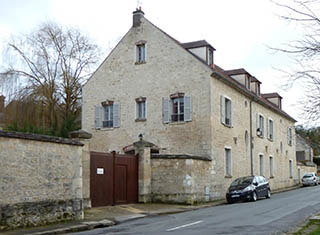Prochain point : lat="49.13873" lon="2.142522"

Dubrulle Factory
An eye witness to the industrial past of the Sausseron valley
An old mill...
Numerous mills were erected in the tenth century along the course of the Sausseron, powered by the driving force of the water and taking advantage of the high flow rate. At the end of the eighteenth century there were fifteen mills, twenty-three in 1806 and twenty in 1831. The decline began in the nineteenth century and the number began to drop until the milling industry disappeared entirely in the second half of the twentieth century.
The path of the Sausseron was greatly modified by the construction of reaches that created the waterfalls needed to drive the mill wheels. The Sausseron has 26 metres of drop over its entire length. The Tourly mill, named after the fief to which it belonged, was considered the most powerful in the valley. The reach that feeds the mill diverts the natural course of the river to the level of the Brécourt estate. Its paddle wheel is activated by a three-metre drop. There are only a few traces of the mill’s original architecture, and neither of the buildings now visible existed in the mid-nineteenth century.
... converted into a factory
The mill was bought in 1906 by Louis Alfred Dubrulle, mayor during World War I. It was converted into foundry producing bronze, copper, brass and aluminium as well as a machine shop. Pauline Alexandrine Dubrulle took over the management of the business on the death of her husband in 1919. The parts manufactured in the factory were mainly commissioned by the automotive sector (grease nipples) and distilleries. The plant had 60 employees on the outbreak of World War II, and it supplied parts for the navy and merchant navy (for machine and anti-aircraft guns). On August 30, 1944 a truck loaded with ammunition exploded 50 metres from the factory, destroying the roof, windows and frame.
Business came to a halt in the late 1950s, when the buildings were converted into housing.




